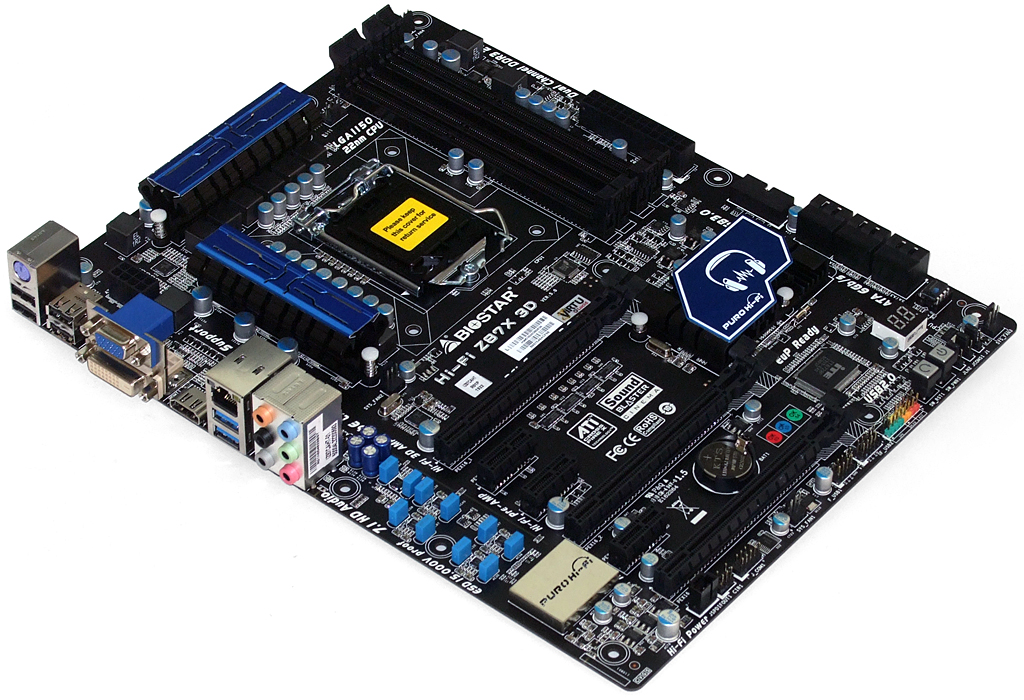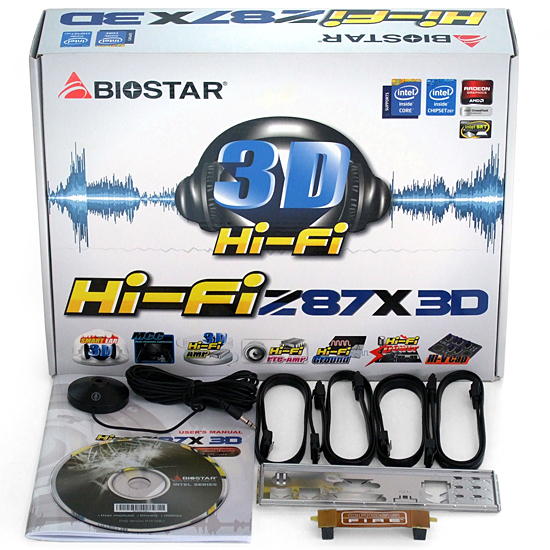Fast And Cheap? Five Sub-$160 Z87 Motherboards For Enthusiasts
Intel’s Haswell architecture has mainstream leanings. And yet some of the motherboards out there are really high-end. Today we're looking at five platforms under the $160 mark that hopefully put some value back into being an enthusiast.
Biostar Hi-Fi Z87X 3D
Why you can trust Tom's Hardware
The name of Biostar’s latest $150 motherboard is much more than a bunch of SEO (search-engine optimized) terms smashed together. The firm promises technology to back its Hi-Fi Z87X 3D’s title. For instance, a group of transistors for its high-current "3D" headphone amplifier (we know, we know...) are plainly visible between the audio codec’s EMI shield and analog audio jacks. The company promises over 100 dB through a pair of high-impedance 600 Ω headphones and a signal-to-noise ratio exceeding 110 dB.
Biostar continues pushing this "Hi-Fi" theme into power circuitry and even the board’s ground layers, claiming less signal interference. I might not have the audio gear to test the company's claims on that subsystem, but I can at least test the value of its low-noise power claims through overclocking.
The "3D" part of the title also refers to simulated 3D through headphones, a technology that’s been around for at least 15 years. Noticing that most of today’s users entered the scene after Aureal disappeared, Biostar states that “It's fantastically, especially if you've never experienced this kind of acoustic phenomenon before," typos and all.
Typically, Biostar leans heavily on a chipset’s integrated features to save cost, so we were a little surprised to only find two of the chipset’s six USB 3.0 ports on the I/O panel. We’d prefer four USB 3.0 ports and a pair of USB 2.0, rather than what the company ended up implementing.
A pair of USB 3.0 ports also connect to a forward-facing front-panel header, leaving two ports wasted in a market where many competitors add hubs just to push beyond Intel's Z87 Express specs.
A single PCIe lane feeds Realtek’s 8111F network controller, and the Hi-Fi Z87X 3D doesn’t even have a PCIe to PCI bridge. That leaves Biostar with seven PCH-based lanes to feed slots, including a x16 interface at the bottom electrically wired to four second-gen lanes. Although three-way CrossFire might be more appealing if Biostar had borrowed PCI Express 3.0 connectivity from the CPU, anyone not running a three-way array will be glad that the bottom slot doesn't tap into the middle-slot's lanes. Besides, consider the market we're addressing with these boards. Is it probable that anyone shopping for a $150 motherboard is going to have three quick Radeon cards or a CPU fast enough to feed them? Not likely. Instead, links originating from the CPU switch from x16-x0 to x8-x8 when that middle slot is populated. The bottom slot can still serve less bandwidth-hungry RAID controllers or video capture cards.
Sticking with Biostar’s previous high-value overclocking theme, we find a substantial 12-phase CPU voltage regulator at the top of the board and an integrated Port 80 display at the bottom. Catering to showmanship, power and reset switches simplify those functions when the board is on an open test bench.
The easiest way to reduce front-panel audio noise is to place its header near the controller. Biostar places its corresponding header directly in front of the I/O panel header so that both connectors can be easily fed by the same amplifier circuit. Cases with short front-panel cables are also easier to wire, but builders who insist upon hiding this cable behind the motherboard tray will probably be disappointed.
Like most of today’s competitors, Biostar includes four SATA cables in its Hi-Fi Z87X 3D installation kit. Unlike those competitors, Biostar also adds a nice microphone.
Get Tom's Hardware's best news and in-depth reviews, straight to your inbox.
-
InvalidError The sad things about "exposing enthusiast features" on z87:Reply
1- the x8x4x4 PCIe controller is a CPU feature in all i5 and i7. All the z*7 chipset does is unlock the CPU feature
2- same goes for multipliers on K-chips: CPU feature locked out by non-z*7 chipsets
3- SATA-6G ports do not really cost Intel any thing extra to put on-chip (little more than a PLL tweak to lock on faster signals), which makes it somewhat of a shame they aren't fully standard
4- USB3 ports do not cost Intel all that much extra either - maybe an extra square millimeter on silicon to upgrade all remaining USB2 ports to USB3
5- the DMI bus can only manage ~20Gbps so it will bottleneck if you attempt to use even 1/5th the total the connectivity available on z87
More connectivity, yes. But DMI lacks the muscle to actually stress that extra IO. As such, it is little more than a glorified SATA port replicator and USB hub.
I almost exclusively use Intel CPUs but it still annoys me how Intel charges extra for trivial things or unlock stuff they arbitrarily locked out just because they can. -
Crashman Reply
It still saves motherboard makers a lot of money when they don't need to add all those controllers. And it frees up some of those x1 slots. Remember that most users don't use "everything at once" to fill up the DMI, so having the x1 slots available rather than consumed by onboard devices adds flexibility to a build.11349374 said:The sad things about "exposing enthusiast features" on z87:
1- the x8x4x4 PCIe controller is a CPU feature in all i5 and i7. All the z*7 chipset does is unlock the CPU feature
2- same goes for multipliers on K-chips: CPU feature locked out by non-z*7 chipsets
3- SATA-6G ports do not really cost Intel any thing extra to put on-chip (little more than a PLL tweak to lock on faster signals), which makes it somewhat of a shame they aren't fully standard
4- USB3 ports do not cost Intel all that much extra either - maybe an extra square millimeter on silicon to upgrade all remaining USB2 ports to USB3
5- the DMI bus can only manage ~20Gbps so it will bottleneck if you attempt to use even 1/5th the total the connectivity available on z87
More connectivity, yes. But DMI lacks the muscle to actually stress that extra IO. As such, it is little more than a glorified SATA port replicator and USB hub.
I almost exclusively use Intel CPUs but it still annoys me how Intel charges extra for trivial things or unlock stuff they arbitrarily locked out just because they can.
In other words, they might be charging for stuff that should be free or should have been included all the way back in the Z68, but past omission doesn't negate current usefullness.
-
DookieDraws I am planning a new Haswell build, soon, and I really appreciate the the effort put into this review. Very helpful!Reply
The market is flooded with tons of these Z87 motherboards and it can be very overwhelming researching them. So, hopefully we'll see a few more Z87 reviews from you guys, soon.
Would also like to see some powerful i7 builds built around more energy efficient components. That would be very interesting. Hint. :) -
Novuake Yeah, I would not be caught dead with a Biostar board. Booo... Interesting that the G45 did not overclock to well, they are usually not the best OCers due to low cost VRMs, thought this would change with Haswell. Hmmm...Reply -
axehead15 I really think that ASRock has taken a lot of steps to put the naysayers to rest. The amount of features that is on these boards for the cost is incredible.Reply
Rather surprised that Biostar had such a good board. Maybe it's time to start considering those boards for future builds. -
JPNpower Can anybody tell me the true difference between the Asus Z87-A and Z-87 plus, without all the marketing hogwash? I'm confused what the difference is. (woth say $15 extra for the plus?)Reply -
vertexx Trying to pick a winner based strictly on the numbers - tough when the measured numbers have been commoditized to the extent they have. Funny to give in on ASRock based on a temporary price break. I think the feature-set vs. value helps ASRock stand on it's own. I really think there is a good target audience for each of these boards. Pulling that out would be a great analysis.Reply
It is great to see a round-up of the mainstream boards, though, so thanks! -
InvalidError Reply
Most users don't have enough such devices to fill every port in the first place (how many people need more than two upper-tier SSDs?) but those who might actually "need" and use 6xSATA-6G would be people wanting to do things like RAID0/1/5 with 3-6x SSDs. At 6x SSDs, we would be looking at ~25Gbps peak not counting GbE, USB3 or PCIe devices on the 8x 2.0 lanes.11349464 said:It still saves motherboard makers a lot of money when they don't need to add all those controllers. And it frees up some of those x1 slots. Remember that most users don't use "everything at once" to fill up the DMI, so having the x1 slots available rather than consumed by onboard devices adds flexibility to a build.
Still does not change the fact that the only reason why Intel gets away with charging $10-15 extra for less than $1 worth of features while the DMI bus lacks the bandwidth to properly support them for people who may actually intend to use them is because they have a practical monopoly which allows them to arbitrarily fragment the market so they can artificially inflate prices.
The main reason most people go with z?7 is the overclock unlock for K-chips. That itself is the biggest joke since it is a completely artificial limitation Intel engineered into their products to enforce co-upselling. As shown with the h87 slip-up, the h87 is perfectly capable of managing multipliers on Haswell K-chips when the K-chip lacks the microcode to enforce the z87 unlock "requirement."
I don't bother with overclocking so this does not affect me... but it still annoys me on the basis of principles and general dislike for hair-splitting for profit.



